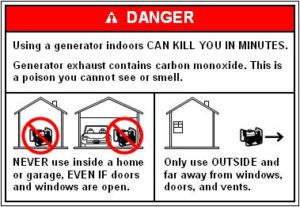More and more people are purchasing generators as they become more affordable and easy to use. Once you’ve had your power out for more than a few hours, purchasing a generator makes a lot of sense. No one wants to throw out a refrigerator full of food or take a shower in the dark. So while a generator can make it a lot more comfortable to ride out a power outage that may occur due to severe weather, they also come with serious risks.
Portable generators gas stoves, lanterns and even burning charcoal or wood, produce deadly carbon monoxide fumes. These fumes are odorless and colorless and are often called the “silent killer”. Over 450 people die each year in the United States from accidental carbon monoxide poisoning, and hundreds more are hospitalized. The leading cause of death by poisoning in the US is from carbon monoxide fumes. These deaths are completely preventable if you follow precautions.
Portable generators produce large amounts of carbon monoxide, even more than your car so here are a few rules you need to follow:
- Never use a portable generator inside your home or any enclosed space. Not for any reason and not even with window open.
- Always place a portable generator outside and away from any window or vents where the fumes could enter the house. More than 20 feet is preferred.
- Never use a portable generator in your garage even if the garage door is fully open. It can kill you.
- Read and follow all the instructions that come with your generator.
- Make sure you have a carbon monoxide detector and check the batteries every season. Some CO detectors are electric, but don’t count on the electricity when the power is going on and off. Make sure you back up your detector with a battery.
It’s important to remember that carbon monoxide poisoning can kill you within seconds. In some cases there are symptoms and warnings that may indicate a potential leak. It’s important to know the symptoms even if you have followed all the safety rules.
- Flu-like symptoms
- Headache
- Dizziness
- Nausea
- Weakness
- Shortness of Breath
- Chest tightness
- Vision changes
- Loss of muscle control
- Confusion and behavioral changes
- Heart flutters
- Skin rash
Because symptoms of CO poisoning can often be mistaken for flu symptoms, it’s important to be aware and know the difference. When in doubt, contact professional help immediately and leave the area. If your symptoms clear up when you go outside, you know you might have a CO problem.
Atkinson Petruska Kozma Hart & Couture have a 35 year history and are advocates of injury victims’ rights. If you or a love one has been the victim of carbon monoxide poisoning due to someone else negligence, call us. We believe in fighting for victims and their families when they cannot fight for themselves and take good care of our clients.
Call Us Toll-Free: 1.877.732.2491

